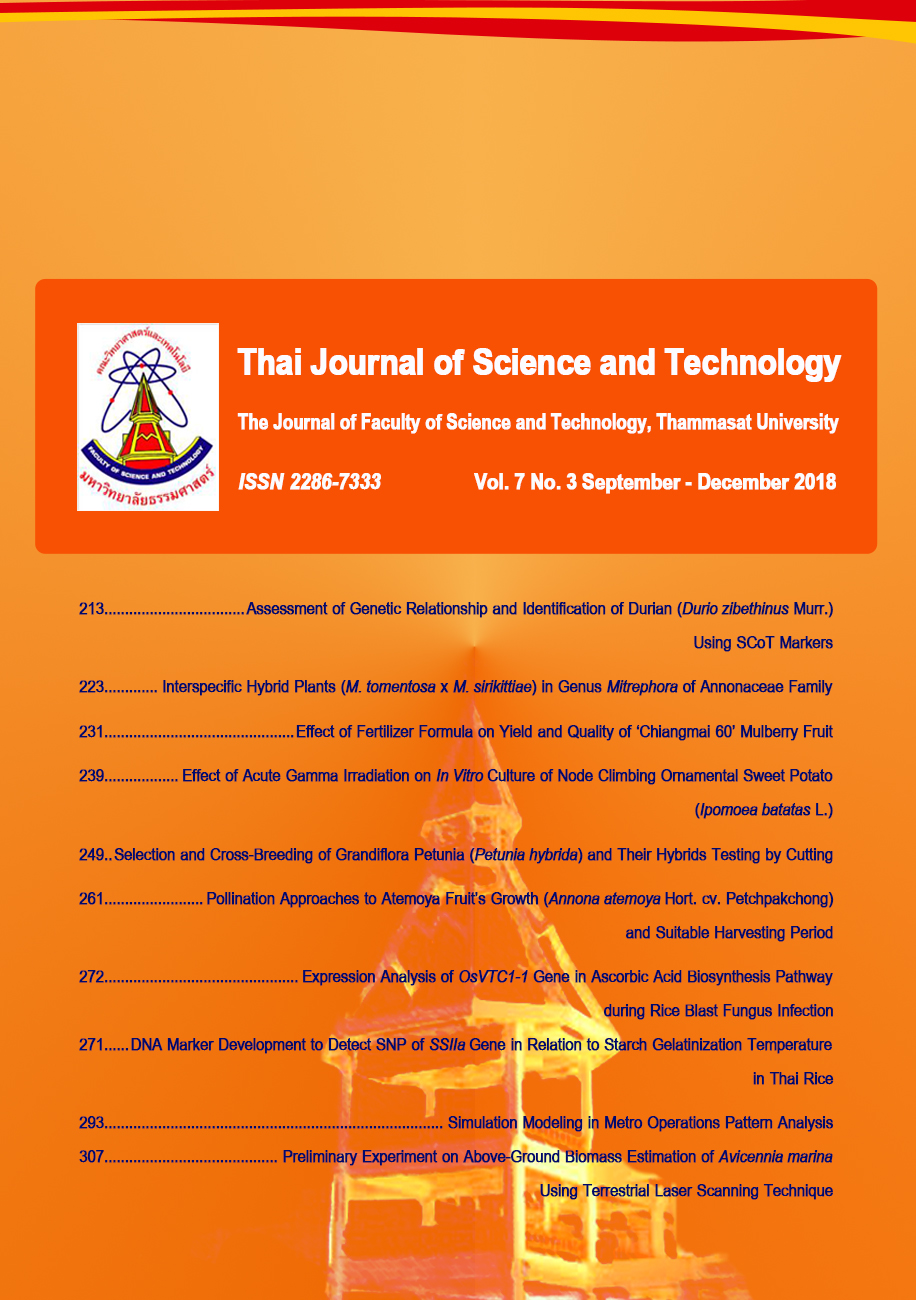การพัฒนาเครื่องหมายดีเอ็นเอเพื่อใช้ตรวจสอบสนิปส์ของยีน SSIIa ที่สัมพันธ์กับอุณหภูมิแป้งสุกในข้าวไทย
Main Article Content
Abstract
บทคัดย่อ
อุณหภูมิแป้งสุกเป็นตัวกำหนดระยะเวลาในการหุงต้ม โดยข้าวที่มีอุณหภูมิแป้งสุกต่ำใช้ระยะเวลาในการหุงต้มน้อยกว่าข้าวที่มีอุณหภูมิแป้งสุกสูง นอกจากนี้ยังมีผลต่อลักษณะเนื้อสัมผัสของข้าวสุกด้วย ยีน SSIIa ควบคุมลักษณะอุณหภูมิแป้งสุกของข้าว โดยการแทนที่เบสที่ตำแหน่ง 4,198 (G/A) และ 4,329-4,330 (GC/TT) ในเอกซอน 8 มีผลมากต่ออุณหภูมิแป้งสุก ในงานวิจัยนี้ได้ออกแบบไพรเมอร์เพื่อตรวจสอบสนิปส์ที่ตำแหน่ง 4,198 โดยวิธีเตตระไพรเมอร์ เออาร์เอ็มเอส พีซีอาร์ พบว่าไพรเมอร์ที่เปลี่ยนแปลงเบสที่ 3 จากปลาย 3¢ ให้ผลการตรวจสอบที่ชัดเจน เมื่อใช้ไพรเมอร์ที่ออกแบบใหม่นี้ตรวจสอบสนิปส์ในตำแหน่ง 4,198 และไพรเมอร์ที่มีรายงานมาก่อนตรวจสอบสนิปส์ตำแหน่ง 4,329-4,330 ในข้าวไทย 69 พันธุ์ และข้าวญี่ปุ่น 3 พันธุ์ พบว่าสนิปส์ตำแหน่ง 4,198 ในข้าวไทยเป็น G เท่านั้น และในข้าวญี่ปุ่น 2 พันธุ์ เป็น A ส่วนสนิปส์ตำแหน่ง 4,329-4,330 พบทั้ง GC และ TT และให้ผลการทดลองเหมือนกับการหาลำดับเบส รูปแบบสนิปส์ GC/TT มีความสัมพันธ์กับอุณหภูมิแป้งสุกของข้าวไทยที่ปลูกทั้งในฤดูนาปีและนาปรัง โดยข้าวที่มีสนิปส์ GC มีอุณหภูมิแป้งสุกสูงกว่าข้าวที่มีสนิปส์ TT อย่างมีนัยสำคัญ ดังนั้นจึงสามารถใช้ไพรเมอร์ในงานวิจัยนี้คัดเลือกข้าวไทยที่มีอุณหภูมิแป้งสุกที่เหมาะสมได้
คำสำคัญ: ข้าว; เครื่องหมายสนิปส์; เตตระไพรเมอร์ เออาร์เอ็มเอส พีซีอาร์; ยีน SSIIa; อุณหภูมิแป้งสุก
Abstract
Gelatinization temperature determines the time required for cooking rice. Low gelatinization temperature rice needs less cooking time than the high gelatinization temperature ones. Furthermore, gelatinization temperature affects cooked rice texture. SSIIa gene controls gelatinization temperature in rice. Base substitutions in SSIIa gene at positions 4,198 (G/A) and 4,329-4,330 (GC/TT) of 8th exon have been found to be responsible for gelatinization temperature. In this research, primers for SNP detection at position 4,198 using tetra-primer ARMS-PCR method were developed. The results showed that primers with change in third base from 3’ end could be used to clearly identify SNP at position 4,198. When the newly developed primers for detecting SNP at position 4,198 and the formerly reported primers to detect SNP at position 4,329-4,330 were used in 69 Thai and 3 Japanese rice, G allele at position 4,198 was detected in all Thai rice tested, while A allele was found in two Japanese rice. At position 4,329-4,330, GC and TT alleles were found. The SNPs detection by tetra-primer ARMS-PCR method were confirmed and found to be consistent with sequencing analysis results. Correlations between GC/TT SNP and gelatinization temperature were found in Thai rice grown in season and off season. Rice with GC SNP had significantly higher gelatinization temperature than those with TT SNP. Therefore, the SNP markers used in this research would be applied in marker-assisted selection for Thai rice with proper gelatinization temperature.
Keyword: rice; SNPs; tetra-primer ARMS-PCR; SSIIa gene; gelatinization temperature
Article Details
บทความที่ได้รับการตีพิมพ์เป็นลิขสิทธิ์ของคณะวิทยาศาสตร์และเทคโนโลยี มหาวิทยาลัยธรรมศาสตร์ ข้อความที่ปรากฏในแต่ละเรื่องของวารสารเล่มนี้เป็นเพียงความเห็นส่วนตัวของผู้เขียน ไม่มีความเกี่ยวข้องกับคณะวิทยาศาสตร์และเทคโนโลยี หรือคณาจารย์ท่านอื่นในมหาวิทยาลัยธรรมศาสตร์ ผู้เขียนต้องยืนยันว่าความรับผิดชอบต่อทุกข้อความที่นำเสนอไว้ในบทความของตน หากมีข้อผิดพลาดหรือความไม่ถูกต้องใด ๆ
References
วราภรณ์ กันทะวงค์, ศันสนีย์ จำจด, นริศ ยิ้มแย้ม และชนากานต์ เทโบลต์ พรมอุทัย, 2558, ความแปรปรวนของคุณภาพการหุงต้มในข้าวพันธุ์พื้นเมืองจากจังหวัดเชียงใหม่ เชียงรายและแม่ฮ่องสอน, แก่นเกษตร 43(4): 687-698.
สมาคมผู้ส่งออกข้าวไทย, ผลผลิตข้าว, แหล่งที่มา : http://www.thairiceexporters.or.th/production.htm, 14 สิงหาคม 2560.
Bao, J.S., Corke, H. and Sun, M., 2006, Nucleotide diversity in starch synthase IIa and validation of single nucleotide polymorphism in relation to starch gelatinization temperature and other physicochemical properties in rice (Oryza sativa L.), Theor. Appl. Genet. 113: 1171-1183.
Caffagni, A., Albertazzi, G., Gavina, G., Ravaglia, S., Gianinetti, A., Pecchioni, N. and Milc, J., 2013, Characterization of an Italian rice germplasm collection with genetic markers useful for breeding to improve eating and cooking quality, Euphytica 194: 383-399.
Fitzgerald, M.A., McCouch, S.R. and Hall, R.D., 2009, Not just a grain of rice: The quest for quality, Trends Plant Sci. 14: 133-139.
Jin, L., Lu, Y., Shao, Y., Zhang, G., Xiao, P., Shen, S. and Corke, H., 2010, Molecular marker assisted selection for improvement of the eating, cooking and sensory quality of rice (Oryza sativa L.), J. Cereal Sci. 51: 159-164.
Juliano, B.O. and Villareal, C.P., 1993, Grain Quality Evaluation of World Rices, International Rice Research Institute, Manila, 218 p.
Lu, Y., Xiao, P., Shao, Y., Zhang, G., Thanyasiriwat, T. and Bao, J., 2010, Development of new markers to genotype the functional SNPs of SSIIa, a gene responsible for gelatinization temperature of rice starch, J. Cereal Sci. 52: 438-443.
Nakamura, Y., Francisco, Jr.P.B., Hosaka, Y., Sato, A., Sawada, T., Kubo, A. and Fujita, N., 2005, Essential amino acids of starch synthase IIa differentiate amylopectin structure and starch quality between japonica and indica rice varieties, Plant
Mol. Biol. 58: 213-227.
R Core Team, R: A language and environment for statistical computing, version 3.0.2. Vienna: R foundation for statistical computing, Available Source: http://www.r-project.org, September 25, 2013.
Shu, X.L., Shen, S.Q., Bao, J.S., Wu, D.X., Nakamura, Y. and Shu, Q.Y., 2006, Molecular and biochemical of the gelatinization temperature characteristics of rice (Oryza satva L.) starch granules, J. Cereal Sci. 44: 40-48.
Xu, F., Zhang, G., Tong, C., Sun, X., Corke, H., Sun, M. and Bao, J., 2013, Association mapping of starch physicochemical properties with starch biosynthesizing genes in waxy rice (Oryza sativa L.), J. Agric. Food Chem. 61: 10110-10117.
Ye, S., Dhillon, S., Ke, X., Collins, A.R. and Day, I.N., 2001, An efficient procedure for genotyping single nucleotide polymer-phisms, Nucl. Acids Res. 29(17): e88-8.


